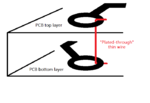neazoi
Advanced Member level 6

Hello, I use the "sandwitched" photochemical teghnique to make double sided PCBs at home. After the PCBs are made, both upper and lower layers must be joined in some points (eg IC sockets).
Joining these points (if no plated-through is done) can be done using wires on single joins.
Or using the better quality IC sockets that extend their pins so they can be soldered on both sides.
In some cases soldering both sides cannot be done, for example on ISA bus connectors, since these components do not extend their pins too much out of the PCB.
What can be done to join the upper and lower layers in these cases without using plated-through?
The only way I can think of, is passing through the hole a very fine wire and solder it on both layers, but without filling out the hole with solder. Prior to soldering the wire, bend it on both sides, so that it cannot pulled out of the hole. Then place in the component and solder it on the bottom side only. The thin wire acts as a plated-through then. Has anyone tried it?
Any other ways you can think of?
Joining these points (if no plated-through is done) can be done using wires on single joins.
Or using the better quality IC sockets that extend their pins so they can be soldered on both sides.
In some cases soldering both sides cannot be done, for example on ISA bus connectors, since these components do not extend their pins too much out of the PCB.
What can be done to join the upper and lower layers in these cases without using plated-through?
The only way I can think of, is passing through the hole a very fine wire and solder it on both layers, but without filling out the hole with solder. Prior to soldering the wire, bend it on both sides, so that it cannot pulled out of the hole. Then place in the component and solder it on the bottom side only. The thin wire acts as a plated-through then. Has anyone tried it?
Any other ways you can think of?
Last edited:



